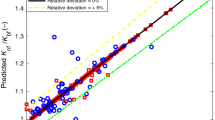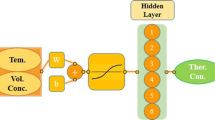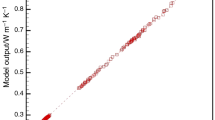Abstract
Nanofluids containing alumina nanoparticles have been used in different thermal devices due to their favorable characteristics including ease of synthesis, relatively high stability and proper thermal features. Nanofluids thermal conductivity could be modeled with high exactness by employing intelligent techniques. In the current paper, thermal conductivity of EG-Water-based nanofluids with alumina particles is modeled by utilizing Multi-Layer Perceptron (MLP) and Group Method of Data Handling (GMDH) as two efficient intelligent approaches. In case of utilizing MLP two transfer functions, tangent sigmoid and radial basis functions, are applied. Results showed that utilizing MLP with radial basis provides the highest precision of the prediction in its optimal architecture. R2 of the models by applying MLP with tansig and radial basis functions and GMDH are 0.9998, 0.9998 and 0.9996, respectively. Furthermore, sensitivity analysis reveals that base fluid thermal conductivity has the most significant role in the thermal conductivity of the considered nanofluids.




Similar content being viewed by others
Change history
18 April 2022
A Correction to this paper has been published: https://doi.org/10.1007/s40799-022-00572-7
References
Jarray A, Mehrez Z, El Cafsi A (2019) Mixed convection Ag-MgO/water hybrid nanofluid flow in a porous horizontal channel. The European Physical Journal Special Topics 2019 228:12 228:2677–2693. https://doi.org/10.1140/EPJST/E2019-900068-8
Hanif H, Khan I, Shafie S (2021) A novel study on hybrid model of radiative Cu– Fe 3 O 4 /water nanofluid over a cone with PHF/PWT. The European Physical Journal Special Topics 2021 230:5 230:1257–1271. https://doi.org/10.1140/EPJS/S11734-021-00042-Y
Ahrar AJ, Djavareshkian MH (2016) Lattice Boltzmann simulation of a Cu-water nanofluid filled cavity in order to investigate the influence of volume fraction and magnetic field specifications on flow and heat transfer. J Mol Liq 215:328–338. https://doi.org/10.1016/J.MOLLIQ.2015.11.044
Mansour MA, Armaghani T, Chamkha AJ, Rashad AM (2019) Entropy generation and nanofluid mixed convection in a C-shaped cavity with heat corner and inclined magnetic field. The European Physical Journal Special Topics 2019 228:12 228:2619–2645. https://doi.org/10.1140/EPJST/E2019-900050-3
Moayedi H (2021) Investigation of heat transfer enhancement of Cu-water nanofluid by different configurations of double rotating cylinders in a vented cavity with different inlet and outlet ports. International Communications in Heat and Mass Transfer 126:105432. https://doi.org/10.1016/J.ICHEATMASSTRANSFER.2021.105432
Selimefendigil F, Öztop HF (2015) Mixed convection in a two-sided elastic walled and SiO2 nanofluid filled cavity with internal heat generation: Effects of inner rotating cylinder and nanoparticle’s shape. J Mol Liq 212:509–516. https://doi.org/10.1016/J.MOLLIQ.2015.09.037
Goodarzi M, Safaei MR, Vafai K, Ahmadi G, Dahari M, Kazi SN, Jomhari N (2014) Investigation of nanofluid mixed convection in a shallow cavity using a two-phase mixture model. Int J Therm Sci 75:204–220. https://doi.org/10.1016/J.IJTHERMALSCI.2013.08.003
Ebrahimi D, Yousefzadeh S, Akbari OA, Montazerifar F, Rozati SA, Nakhjavani S, Safaei MR (2021) Mixed convection heat transfer of a nanofluid in a closed elbow-shaped cavity (CESC). Journal of Thermal Analysis and Calorimetry 2021 144:6 144:2295–2316. https://doi.org/10.1007/S10973-021-10548-1
Alhuyi Nazari M, Ahmadi MH, Ghasempour R, Shafii MB (2018) How to improve the thermal performance of pulsating heat pipes: A review on working fluid. Renew Sust Energ Rev 91:630–638. https://doi.org/10.1016/j.rser.2018.04.042
Heris SZ, Shokrgozar M, Poorpharhang S, Shanbedi M, Noie SH (2014) Experimental Study of Heat Transfer of a Car Radiator with CuO/Ethylene Glycol-Water as a Coolant. J Dispers Sci Technol 35:677–684. https://doi.org/10.1080/01932691.2013.805301
Fikri MA, Asri FF, Faizal WM, Adli HK, Mamat R, Azmi WH, Najafi G, Yusaf T (2020) TiO2-SiO2 nanofluid characterization: Towards efficient with water/ethylene glycol mixture for solar application. IOP Conference Series: Materials Science and Engineering 863:012055. https://doi.org/10.1088/1757-899X/863/1/012055
Menbari A, Alemrajabi AA, Ghayeb Y (2016) Experimental investigation of stability and extinction coefficient of Al2O3–CuO binary nanoparticles dispersed in ethylene glycol–water mixture for low-temperature direct absorption solar collectors. Energy Convers Manag 108:501–510. https://doi.org/10.1016/J.ENCONMAN.2015.11.034
Zakaria I, Mohamed WANW, Mamat AMIB, Saidur R, Azmi WH, Mamat R, Talib SFA (2015) Experimental Investigation of Al2O3 - Water Ethylene Glycol Mixture Nanofluid Thermal Behaviour in a Single Cooling Plate for PEM Fuel Cell Application. Energy Procedia 79:252–258. https://doi.org/10.1016/J.EGYPRO.2015.11.474
Ghanbarpour M, Nikkam N, Khodabandeh R, Toprak MS, Muhammed M (2015) Thermal performance of screen mesh heat pipe with Al2O3 nanofluid. Exp Thermal Fluid Sci 66:213–220. https://doi.org/10.1016/J.EXPTHERMFLUSCI.2015.03.024
Qu J, Wu H (2010) ying; Cheng, P. Thermal performance of an oscillating heat pipe with Al2O3-water nanofluids. International Communications in Heat and Mass Transfer 37:111–115. https://doi.org/10.1016/j.icheatmasstransfer.2009.10.001
Yousefi T, Veysi F, Shojaeizadeh E, Zinadini S (2012) An experimental investigation on the effect of Al2O3–H2O nanofluid on the efficiency of flat-plate solar collectors. Renew Energy 39:293–298. https://doi.org/10.1016/J.RENENE.2011.08.056
Tong Y, Lee H, Kang W, Cho H (2019) Energy and exergy comparison of a flat-plate solar collector using water, Al2O3 nanofluid, and CuO nanofluid. Appl Therm Eng 159:113959. https://doi.org/10.1016/J.APPLTHERMALENG.2019.113959
Bondarenko DS, Sheremet MA, Oztop HF, Ali ME (2019) Natural convection of Al2O3/H2O nanofluid in a cavity with a heat-generating element. Heatline visualization. Int J Heat Mass Transf 130:564–574. https://doi.org/10.1016/J.IJHEATMASSTRANSFER.2018.10.091
Chamkha AJ, Abu-Nada E (2012) Mixed convection flow in single- and double-lid driven square cavities filled with water–Al2O3 nanofluid: Effect of viscosity models. European Journal of Mechanics - B/Fluids 36:82–96. https://doi.org/10.1016/J.EUROMECHFLU.2012.03.005
Hashim I, Alsabery AI, Sheremet MA, Chamkha AJ (2019) Numerical investigation of natural convection of Al2O3-water nanofluid in a wavy cavity with conductive inner block using Buongiorno’s two-phase model. Adv Powder Technol 30:399–414. https://doi.org/10.1016/J.APT.2018.11.017
Pare A, Ghosh SK (2021) A unique thermal conductivity model (ANN) for nanofluid based on experimental study. Powder Technol 377:429–438. https://doi.org/10.1016/J.POWTEC.2020.09.011
Maleki A, Haghighi A, Irandoost Shahrestani M, Abdelmalek Z (2020) Applying different types of artificial neural network for modeling thermal conductivity of nanofluids containing silica particles. J Therm Anal Calorim. https://doi.org/10.1007/s10973-020-09541-x
Rashidi, M.M.; Nazari, M.A.; Mahariq, I.; Assad, M.E.H.; Ali, M.E.; Almuzaiqer, R.; Nuhait, A.; Murshid, N. Thermophysical Properties of Hybrid Nanofluids and the Proposed Models: An Updated Comprehensive Study. Nanomaterials 2021, Vol. 11, Page 3084 2021, 11, 3084, https://doi.org/10.3390/NANO11113084
Maleki, A.; Elahi, M.; Assad, M.E.H.; Alhuyi Nazari, M.; Safdari Shadloo, M.; Nabipour, N. Thermal conductivity modeling of nanofluids with ZnO particles by using approaches based on artificial neural network and MARS. Journal of Thermal Analysis and Calorimetry 2020, 1–12, https://doi.org/10.1007/s10973-020-09373-9
Ghazvini M, Maddah H, Peymanfar R, Ahmadi MH, Kumar R (2020) Experimental evaluation and artificial neural network modeling of thermal conductivity of water based nanofluid containing magnetic copper nanoparticles. Physica A: Statistical Mechanics and its Applications 124127. https://doi.org/10.1016/j.physa.2019.124127
Hemmat Esfe M, Motallebi SM, Bahiraei M (2021) Employing response surface methodology and neural network to accurately model thermal conductivity of TiO2–water nanofluid using experimental data. Chin J Phys 70:14–25. https://doi.org/10.1016/J.CJPH.2020.12.012
Ahmadi MH, Ahmadi MA, Nazari MA, Mahian O, Ghasempour R (2019) A proposed model to predict thermal conductivity ratio of Al2O3/EG nanofluid by applying least squares support vector machine (LSSVM) and genetic algorithm as a connectionist approach. J Therm Anal Calorim 135:271–281. https://doi.org/10.1007/s10973-018-7035-z
Ahmadi MH, Alhuyi Nazari M, Ghasempour R, Madah H, Shafii MB, Ahmadi MA (2018) Thermal conductivity ratio prediction of Al2O3/water nanofluid by applying connectionist methods. Colloids Surf A Physicochem Eng Asp 541:154–164. https://doi.org/10.1016/J.COLSURFA.2018.01.030
Khosrojerdi S, Vakili M, Yahyaei M, Kalhor K (2016) Thermal conductivity modeling of graphene nanoplatelets/deionized water nanofluid by MLP neural network and theoretical modeling using experimental results. International Communications in Heat and Mass Transfer 74:11–17. https://doi.org/10.1016/J.ICHEATMASSTRANSFER.2016.03.010
Wang N, Maleki A, Alhuyi Nazari M, Tlili I, Safdari Shadloo M (2020) Thermal conductivity modeling of nanofluids contain MgO particles by employing different approaches. Symmetry 12:206
Maleki A, Haghighi A, Mahariq I (2021) Machine learning-based approaches for modeling thermophysical properties of hybrid nanofluids: A comprehensive review. J Mol Liq 322:114843
Syam Sundar L, Venkata Ramana E, Singh MK, Sousa ACM (2014) Thermal conductivity and viscosity of stabilized ethylene glycol and water mixture Al2O3 nanofluids for heat transfer applications: An experimental study. International Communications in Heat and Mass Transfer 56:86–95. https://doi.org/10.1016/J.ICHEATMASSTRANSFER.2014.06.009
Elias MM, Mahbubul IM, Saidur R, Sohel MR, Shahrul IM, Khaleduzzaman SS, Sadeghipour S (2014) Experimental investigation on the thermo-physical properties of Al2O3 nanoparticles suspended in car radiator coolant. International Communications in Heat and Mass Transfer 54:48–53. https://doi.org/10.1016/j.icheatmasstransfer.2014.03.005
Özerinç, S.; Kakaç, S.; YazIcIoǧlu, A.G. Enhanced thermal conductivity of nanofluids: a state-of-the-art review. Microfluidics and Nanofluidics 2009 8:2 2009, 8, 145–170, https://doi.org/10.1007/S10404-009-0524-4
Baghban A, Kahani M, Nazari MA, Ahmadi MH, Yan W-M (2019) Sensitivity analysis and application of machine learning methods to predict the heat transfer performance of CNT/water nanofluid flows through coils. Int J Heat Mass Transf 128:825–835. https://doi.org/10.1016/J.IJHEATMASSTRANSFER.2018.09.041
Alagumalai A, Qin C, Vimal K, Solomine E, Yang L, Zhang P, Otanicar T, Kasaeian A, Chamkha AJ, Rashidi MM, Wongwises S, Seon Ahn H, Lei Z, Saboori T, Mahian O (2022) Conceptual analysis framework development to understand barriers of nanofluid commercialization. Nano Energy 92:106736. https://doi.org/10.1016/j.nanoen.2021.106736
Rashidi MM, Sadri M, Sheremet M (2021) Numerical simulation of hybrid nanofluid mixed convection in a lid-driven square cavity with magnetic field using high order compact scheme. Nanomaterials 11(9):2250. https://doi.org/10.3390/nano11092250
Author information
Authors and Affiliations
Corresponding author
Ethics declarations
Conflict of interests
There is no conflict of interests between the authors.
Additional information
Publisher’s Note
Springer Nature remains neutral with regard to jurisdictional claims in published maps and institutional affiliations.
This article was updated to correct I. Mahariq’s affiliation.
Rights and permissions
About this article
Cite this article
Rashidi, M., Alhuyi Nazari, M., Mahariq, I. et al. Modeling and Sensitivity Analysis of Thermal Conductivity of Ethylene Glycol-Water Based Nanofluids with Alumina Nanoparticles. Exp Tech 47, 83–90 (2023). https://doi.org/10.1007/s40799-022-00567-4
Received:
Accepted:
Published:
Issue Date:
DOI: https://doi.org/10.1007/s40799-022-00567-4




